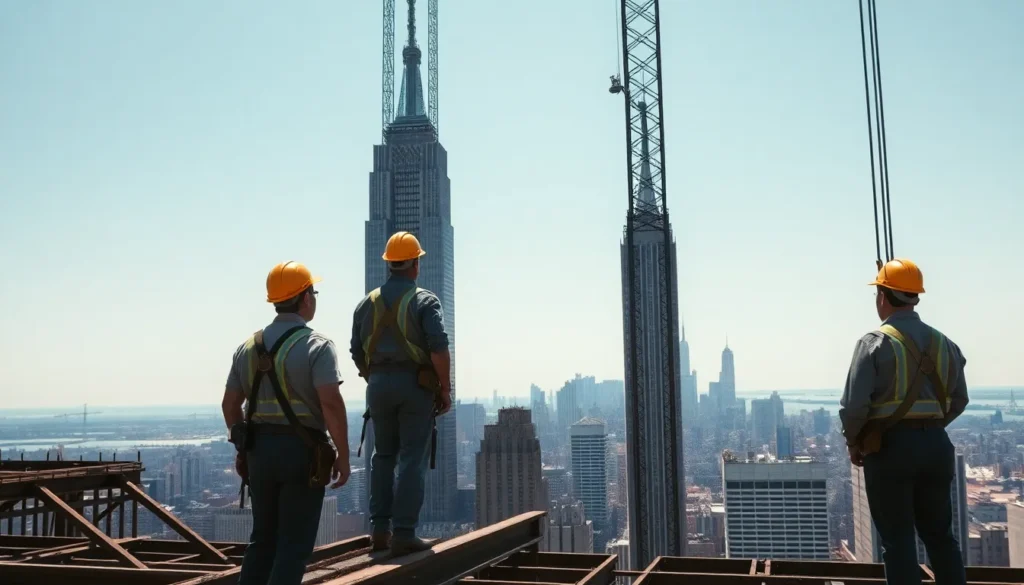Table of Contents
ToggleThe Empire State Building isn’t just a skyscraper; it’s a symbol of ambition, resilience, and a touch of New York magic. Completed in a record-breaking 410 days during the Great Depression, this architectural marvel rose from the ground like a phoenix. Imagine a construction site bustling with workers, a race against time, and a dream so big it could almost give King Kong a run for his money.
As the tallest building in the world for nearly 40 years, the Empire State Building transformed the skyline and captured the hearts of millions. It’s a story filled with grit, determination, and perhaps a few too many cups of coffee. Dive into the fascinating journey of how this iconic structure went from blueprint to breathtaking reality, and discover the secrets behind its enduring legacy.
Overview of Empire State Building Construction
Constructed in the early 1930s, the Empire State Building showcases engineering ingenuity. It commenced on March 17, 1930, and completed in just 410 days, a remarkable feat given the era’s economic challenges. Funding for the project came from John J. Raskob, a businessman, and the Equitable Life Assurance Society.
Designed by the architectural firm Shreve, Lamb & Harmon, the structure reaches 1,454 feet, including its antenna. More than 3,400 workers contributed to its construction, utilizing over 60,000 tons of steel. Innovations like the use of the new technique known as “fast-track construction” sped up the building process significantly.
Materials sourced from across the country included Indiana limestone and granite from the Adirondacks. Workers installed around 6,500 windows during the construction phase, contributing to the building’s distinct aesthetic.
In just under a year and a half, it transformed from a skeletal structure into a symbol of New York City and American perseverance. Around 1,860 concrete mixers operated continuously to ensure a steady workflow. Despite the Great Depression’s challenges, the project remained on schedule and within budget.
This ambitious endeavor set the standard for skyscraper construction in the United States, inspiring future generations of architects and builders. Each element of the Empire State Building reflects a commitment to excellence and innovation, solidifying its status as an iconic piece of architecture.
Historical Context

The Empire State Building’s construction unfolded during a transformative period in American history. Understanding this context highlights its significance beyond architecture.
The Great Depression Era
The Great Depression challenged the nation’s economy in the 1930s. Construction on the Empire State Building began on March 17, 1930, serving as a beacon of hope. Many viewed this monumental project as a sign of resilience amid widespread unemployment and business failures. Over 3,400 workers took part in this ambitious endeavor, demonstrating determination in the face of adversity. Rapid construction techniques reduced timelines and provided jobs, showcasing innovation. Completing the structure in just 410 days stands as a testament to collective effort. Each brick laid contributed to a narrative of recovery and strength, resonating with millions during those trying times.
Urban Development in New York City
Urban development in New York City accelerated in the early 20th century. The Empire State Building emerged in response to increasing demand for office space. Architects and builders aimed to create a structure that would redefine the skyline. This iconic skyscraper symbolized progress and ambition. It rose amidst a landscape dotted with smaller buildings, signaling a shift to vertical expansion. The influence of the building spurred further skyscraper construction throughout the city. More than just a structure, it helped shape the identity of New York City, intertwining with its rich history and culture.
Architectural Design
The architectural design of the Empire State Building reflects a blend of artistry and functionality. This iconic structure stands as an excellent example of early 20th-century Art Deco architecture, characterized by streamlined forms and decorative motifs.
Influences and Inspiration
Significant architectural trends influenced the Empire State Building’s design. The skyscraper embraced the Art Deco style, inspired by various sources like the Chrysler Building and the Woolworth Building. Designers drew from the advancements in engineering, which allowed for taller and more elaborate structures. Additionally, the building’s design aimed to symbolize hope and progress during the Great Depression, making it a beacon of resilience.
Key Architects and Engineers
The architectural team behind the Empire State Building included renowned figures like Shreve, Lamb & Harmon. William F. Lamb served as the principal designer, integrating innovative techniques to maximize height while ensuring structural integrity. Collaboration between architects and engineers was crucial, ensuring that aesthetic elements aligned with the practical requirements of the building. Their combined expertise resulted in a landmark that transformed the New York skyline, influencing future projects worldwide.
Construction Process
The construction process of the Empire State Building exemplifies efficiency and innovation during a tumultuous time in American history.
Timeline of Construction
Construction commenced on March 17, 1930. Within just 410 days, the project reached completion on May 1, 1931. Each phase of construction was meticulously planned to ensure rapid progress. Daily operations involved over 3,400 workers, contributing to a consistently busy site. Initial excavation and foundation work included the removal of over 60,000 cubic yards of earth. Following the foundation, the steel framework rose quickly, reaching the building’s impressive height. The use of “fast-track construction” enabled simultaneous work on multiple sections, helping to meet the ambitious timeline. Despite the Great Depression, the project maintained a steady momentum, symbolizing hope and resilience.
Innovative Techniques and Materials
Innovative techniques played a crucial role in the Empire State Building’s construction. The project adopted a fast-track approach, allowing tasks to overlap and minimize delays. Workers utilized over 60,000 tons of steel, a groundbreaking feat for its time. Concrete mixers operated continuously, maintaining a constant flow of material on-site. Skillful craftsmen installed approximately 6,500 windows, emphasizing both form and function. Indiana limestone and granite from the Adirondacks contributed to the building’s unique aesthetic. The integration of modern construction methods showcased engineering advancements, influencing future skyscraper designs across the nation. Collaborations among architects, engineers, and laborers resulted in a landmark that epitomizes excellence and innovation.
Impact on New York City
The Empire State Building profoundly influenced New York City during and after its construction. This iconic skyscraper became a catalyst for economic growth in the region.
Economic Contributions
Economic activity surged during the construction of the Empire State Building. Hundreds of jobs emerged, directly involving over 3,400 workers. Beyond construction, the building attracted tenants, generating ongoing revenue streams. Office space demand expanded significantly as businesses sought high-profile locations. Increased tourism also contributed to the local economy, with millions visiting the observatory for breathtaking views. The project stimulated various sectors like manufacturing and services, enhancing overall job creation. Each dollar spent on the building reverberated through the city, supporting countless enterprises.
Cultural Significance
Culturally, the Empire State Building serves as a symbol of hope and resilience. It embodies the American spirit during the Great Depression, reflecting the determination to rise above adversity. Film and media often feature the building, solidifying its status in popular culture. Iconic movies showcased its towering presence, promoting New York City as a global destination. Architectural debates surround its Art Deco style, influencing various design trends. Community events and celebrations frequently take place at the landmark, fostering a sense of local pride. This skyscraper not only reshaped the skyline but also enriched the city’s cultural identity.
The Empire State Building stands as a testament to human ingenuity and determination. Its construction during one of America’s most challenging periods showcases the spirit of resilience that defines the nation. Rising above the skyline it not only transformed New York City but also set a benchmark for architectural excellence.
As a cultural icon it continues to inspire generations and remains a symbol of hope and ambition. The legacy of the Empire State Building is woven into the fabric of the city it adorns, reflecting a rich history that resonates with millions around the world. Its story is one of triumph that will endure for years to come.








